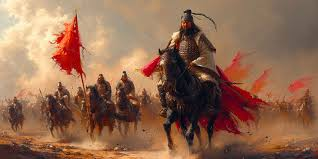The Mongol Empire, one of the largest empires in history, left an indelible mark on many regions, including Eastern Europe. Stretching across Asia and into Europe, this empire profoundly influenced the political, economic, and cultural landscapes of the areas it touched. But what was it about the Mongols that left Eastern Europe so transformed? Let’s dive into their impact and uncover the story behind their influence.
A Glimpse into the Mongol Empire
The Mongol Empire, founded by Genghis Khan in the early 13th century, was a force to be reckoned with. At its height, it spanned from the Pacific Ocean to Eastern Europe, covering about 24 million square kilometers. The Mongols were known for their military prowess, strategic brilliance, and ability to adapt to and integrate diverse cultures.
The Initial Encounter: Eastern Europe Meets the Mongols
In the early 1240s, the Mongols, under the leadership of Batu Khan, launched their westward expansion. This brought them into direct contact with Eastern European states such as Hungary, Poland, and the principalities of Kievan Rus. For many, the Mongol invasion was a baptism by fire, as they faced an army that was both ferocious and disciplined.
The Battle of Legnica (1241)
One of the first major encounters was the Battle of Legnica in 1241, where a combined force of Poles, Czechs, and Germans tried to repel the Mongols. Despite their efforts, the Mongols’ superior tactics led to a decisive victory. This battle underscored the Mongols’ military superiority and sent shockwaves through Europe.
The Golden Horde and Its Influence
The Mongol Empire’s westernmost division, the Golden Horde, played a significant role in shaping Eastern Europe. Centered in the steppes north of the Caspian and Black Seas, the Golden Horde exerted control over vast swathes of Eastern Europe for centuries.
Political Dominance and Tribute
The Golden Horde established a system of political dominance over Russian principalities, requiring them to pay tribute. This system, known as the “Mongol Yoke,” significantly influenced the political structure of the region. Russian princes became vassals to the khans, and the Mongols often mediated disputes between them, consolidating their control.
Urban Development and Trade
Under the Mongols, trade flourished. They revitalized the Silk Road and integrated Eastern Europe into this vast trade network. Cities like Sarai and Novgorod became bustling trade hubs, benefiting from the exchange of goods, ideas, and cultures.
The Impact of Micro-Credentials on Student Learning: A New Approach to Skills Development
Cultural Exchange and Integration
While the Mongols were often seen as conquerors, their influence wasn’t solely destructive. They facilitated cultural exchanges that enriched Eastern Europe in unexpected ways.
Religious Tolerance
The Mongols practiced religious tolerance, allowing diverse faiths to coexist within their empire. This policy influenced Eastern Europe, where interactions among Orthodox Christians, Muslims, and other faiths became more common.
Art and Architecture
Mongol influence can also be seen in Eastern European art and architecture. Elements of Mongol design, such as domed roofs and intricate patterns, began to appear in local buildings, blending with existing styles.

The Role of the Mongols in Shaping Modern Russia
Russia, in particular, felt the weight of Mongol influence. The Mongol Yoke reshaped the region’s political structure, economy, and even its cultural identity.
Centralization of Power
One of the most significant impacts was the centralization of power. The Mongols’ administrative system laid the groundwork for the rise of Moscow as a dominant power. Over time, Moscow’s princes leveraged their position as tax collectors for the Mongols to consolidate power, eventually leading to the unification of Russia.
Military Reforms
The Mongols’ military tactics and organization profoundly influenced Russian armies. Strategies such as rapid cavalry movements and psychological warfare were adopted and adapted by Russian forces.
The Darker Side: Destruction and Devastation
While the Mongols brought trade and cultural exchange, their invasions were also marked by widespread destruction.
Devastation of Cities
Many cities in Eastern Europe, including Kyiv, suffered immense destruction during the Mongol invasions. Entire populations were slaughtered, and infrastructure was razed, leading to long-term economic and demographic consequences.
Population Decline
The invasions resulted in significant population declines due to warfare, famine, and disease. This demographic shift had lasting effects on the region’s development.
The Economic Impact of the Mongol Rule
The Mongols’ impact on Eastern Europe’s economy was multifaceted, involving both destruction and revitalization.
Boosting Trade Networks
The Mongols’ control of trade routes brought Eastern Europe into closer contact with Asia. This integration fostered the exchange of goods such as silk, spices, and precious metals, enriching local economies.
Imposing Heavy Tributes
However, the heavy tributes demanded by the Mongols drained resources from local economies. This often placed a significant burden on the peasantry and stifled economic growth in some regions.
Legacy of the Mongol Empire in Eastern Europe
The Mongols’ influence in Eastern Europe didn’t end with their decline. Their legacy continued to shape the region in various ways.
Political and Administrative Systems
The centralized governance introduced during the Mongol period influenced the development of strong, centralized states in Eastern Europe. This legacy is particularly evident in Russia.
Cultural Syncretism
The blending of Mongol and Eastern European cultures left a lasting imprint on art, language, and traditions, creating a unique cultural synthesis.
Did the Mongols Pave the Way for Modernity?
Some historians argue that the Mongols inadvertently set the stage for modernity in Eastern Europe. By integrating the region into global trade networks and introducing new administrative practices, they laid the groundwork for future developments.
Conclusion
The Mongol Empire’s impact on Eastern Europe was profound and multifaceted. While their invasions brought devastation, they also facilitated trade, cultural exchange, and political centralization. The echoes of their influence can still be felt today, shaping the history and identity of the region.
The Byzantine Empire’s Naval Power: A Force to Be Reckoned With
FAQs
1. How did the Mongols influence Eastern Europe’s political structure?
The Mongols introduced centralized governance and a tribute system, which influenced the development of strong centralized states, particularly in Russia.
2. What was the “Mongol Yoke”?
The “Mongol Yoke” refers to the period during which Russian principalities were under Mongol control and had to pay tribute to the Golden Horde.
3. Did the Mongols promote trade in Eastern Europe?
Yes, the Mongols revitalized trade routes and integrated Eastern Europe into the Silk Road network, boosting trade and cultural exchange.
4. Were the Mongols solely destructive in Eastern Europe?
No, while they caused significant destruction, they also facilitated cultural exchanges, trade, and the spread of new administrative practices.
5. How did the Mongols affect Russian military strategies?
Russian military strategies were heavily influenced by Mongol tactics, including rapid cavalry movements and psychological warfare.


